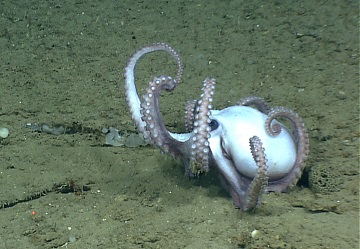380515-octopus crawl.jpg

Octopuses coordinate eight "arms" to crawl across the ocean floor. Credit: National Oceanic and Atmospheric Administration
For those of us who have a tough enough time getting around on two legs, trying to coordinate eight limbs sounds just about impossible. Yet the octopus does it all the time — it uses eight “arms” to crawl across the ocean floor. And some recent research says that crawling motion may not be all that complicated — the octopus decides which way it wants to go, then just pushes off.
Scientists recorded the motions of crawling octopuses, then looked at the video frame by frame. And they found that there are two keys to the way an octopus crawls.
First, its arms are arranged in a symmetrical pattern — those on the left side of the body are laid out in a mirror image of those on the right. And second, the arms move the octopus by simply stretching and pushing against the nearest surface. The combination of a simple layout and simple motion makes it easy for the octopus to move in any direction.
And the octopus doesn’t have to turn its body to change directions — it simply switches arms. So it can be facing straight ahead but easily move at any angle.
In fact, the researchers found that octopuses prefer not to move straight ahead or straight back. That may be because of their field of view. An octopus’s eyes are on the sides of its head, with each eye taking in a full 180-degree field of view. Where the view from the two eyes meets — either straight ahead or straight behind — is actually where the octopus’s vision is weakest — directions where it doesn’t want those eight arms to carry it.
This episode of Science and the Sea was made possible by Texas Sea Grant.

